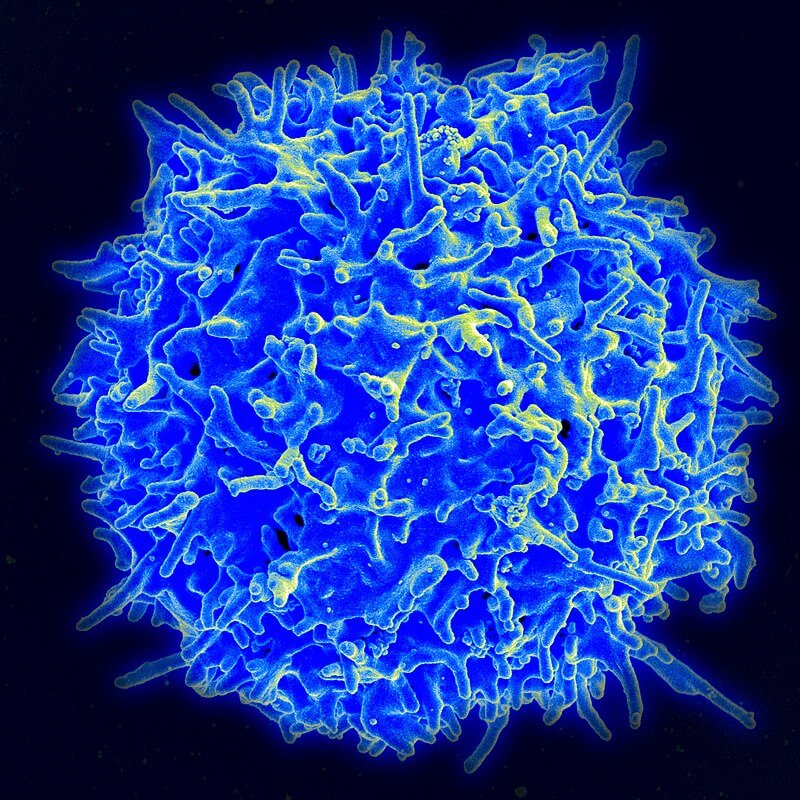- Scientists are making “living drugs” from patient’s own immune cells, ideally giving them greater power to attack cancer cells.
- Engineered T-cell receptor (eTCR) products have the potential to attack solid tumors by targeting cancer-specific antigens inside the cell.
- eTCR treatments are still in development but show promise in clinical trials.
Medically reviewed by Sarah Nikiforow, MD, PhD; George Demetri, MD; and Caron Jacobson, MD
Among the most powerful new cancer treatments being developed today are “living drugs,” which are made by genetically modifying a patient or normal donor’s immune cell. The genetic modification is designed to alter the cells so that, when returned to the patient’s body, they home in on tumors and destroy them.
The key to these drugs, a form of cell therapy, is introducing targeting receptors on immune T cells. These receptors are engineered to recognize identifying molecules, or antigens, on cancer cells.
One example of immune cell therapy is CAR T-cell therapy, a technology that involves fitting a patient’s immune T cells with chimeric antigen receptors (artificial and often antibody-based molecules that match up with an antigen found on blood cancer cells). CAR T products are approved for clinical use in certain adult and pediatric blood cancer patients and have had some dramatic successes in patients with advanced cancers.
Engineered T-cell receptor therapy
Another type of immune cell therapy, of potentially wider use because it may be more effective against solid tumors, is engineered T-cell receptor (eTCR) therapy.
Like CAR T cells, eTCR are typically made from the patient’s own immune T cells, but their targeting molecules are based on natural receptor components similar to those already present on T cells.

Unlike CAR T cells, eTCR can target antigens inside tumor cells present in the body when they are given back to the patient. CAR T cells are limited by their ability to mainly recognize antigens that are on the surface of cancer cells — and that is a minority of antigens.
eTCRs are still in development and haven’t been approved for use outside clinical trials. But they have shown some successes in clinical studies treating solid tumors, including melanoma, colorectal cancer, synovial sarcoma, and multiple myeloma.
eTCR must be compatible with patient’s HLA genotype
eTCR can recognize cancer-specific antigens that are buried within tumor cells because those antigens are broken up into pieces and “presented” to the T-cell receptors by HLA (Human Leukocyte Antigen) molecules on the tumor cell surface.
Unlike CAR T cells, eTCRs need to be matched with the patient’s specific HLA type (sort of like a more sophisticated version of the “blood type”), so scientists are making eTCRs that are compatible with the most common HLA types found in the population.
“We all have different HLA genotypes, so the engineered T-cell receptors have to be specific both for the tumor antigen and the patient’s own HLA molecule,” explains Caron Jacobson, MD, medical director of the Immune Effector Cell therapy program at Dana-Farber.
Researchers are interested in developing eTCR therapies because of the need for better treatments for solid tumors, which are much more common than blood cancers. Trials of eTCR products are in early stages at Dana-Farber and have been used in trials of patients with synovial sarcoma, for which there is a need for better treatments. The results have not been dramatic, according to George Demetri, MD, senior vice president for experimental therapeutics at Dana-Farber.
“It’s a promising technology that has yet to prove itself,” he says.
Dana-Farber oncologist Glenn Hanna, MD, is leading the DFCI efforts on a nation-wide trial that will use engineered T cell receptors to target a viral oncoprotein to treat advanced head and neck cancers caused by the human papilloma virus (HPV).
Many researchers and patients are eagerly awaiting the outcomes of these eTCR trials and wider availability of these therapies in solid tumors.

Would this help with lung cancer?
Thank you for reading. Due to the high volume of comments we receive, we are usually unable to respond to each person individually. If you have a specific medical question related to this blog post, we would recommend talking to your doctor or other care provider. We’ve also gathered answers to some of the more frequent questions below:
-For more information on a particular type of cancer or the latest updates we have available, please visit our website (https://www.dana-farber.org/) or search our blog by clicking the magnifying glass at the top of our homepage: https://blog.dana-farber.org/insight/
-For information on whether you would be eligible for a certain treatment, please visit our website for more information on how to make an appointment or get an online second opinion: https://www.dana-farber.org/appointments-and-second-opinions/
-For information on clinical trials available at Dana-Farber and elsewhere, please visit the Dana-Farber database: https://www.dana-farber.org/research/clinical-trials/find-a-clinical-trial/. For clinical trials outside of Dana-Farber: http://www.clinicaltrials.gov.
Wishing you all the best,
Dana-Farber Insight team